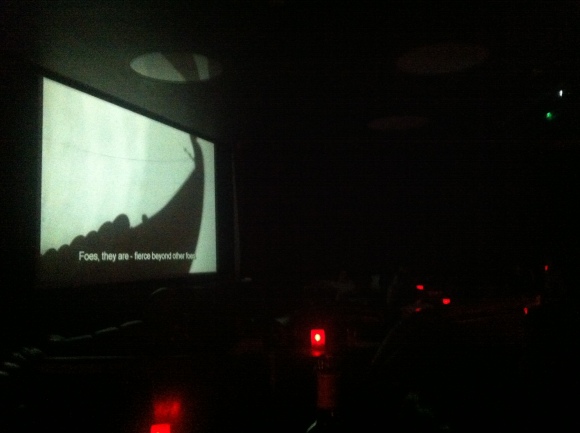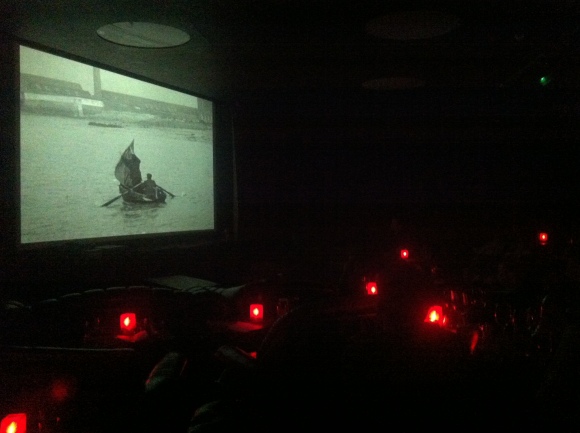
‘From the Sea to the Land Beyond’
Waves breaking on the shore appear in cinema from the pioneering kinetoscope nature documentary Rough Sea at Dover (1895) to last year’s documentary The Secret History of Waves (2012), and were a returning feature of this week’s Passengerfilms event. The screening combined archival coast footage with live music and discussion of film scoring and landscape.
The J. B. Holmes documentary The Way to the Sea (1936), a part collaboration with composer Benjamin Britten (score) and poet W. H. Auden (narrative), retold the story of the electrification of the London-Portsmouth line and the superimposing of the National Grid on the old Roman road to the sea. Starting in AD 286, it gave a rapid history of invasions and shipping, finishing with Auden’s eccentric address to this century’s leisure-seekers on the ‘last straight run to the rolling plain of ships and the path of the gull’. The text (‘we seek… the sea!’) is available in full online here.

‘Foes, they are’ – guess who? in ‘The Way to the Sea’
Dr. Julie Brown, reader in music at Royal Holloway, discussed the remaining evidence of the scores of the Royal Geographical Society expeditionary films to Mount Everest (kinematographer J. B. Noel’s 1923 and 1924 films). As well as presenting the guttural Tibetan music which inspired the movements, she traced the history of the films’ exhibition in Britain, including live performances by visiting Tibetan monks, and played samples of her own reconstructed ‘palimpsest’ score.

Julie Brown playing her reconstructed accompaniment to ‘The Epic of Everest’

‘Into a Fairyland of Ice’, Epic of Everest intertitle
Guitarist and viola-player Kieron Maguire then introduced ‘The Shanty of Living Cinema’, a collection of extracts from experimental coastal films with a live soundtrack by himself and Robert Parkinson (dulcimer) of The Cabinet of Living Cinema. His talk moved from the sea horizon to the fascination with sea creatures in surrealist cinema. The film ‘The Salmon Jumped Over the Sun’ (Guinane, 2009) uses a canoe to film the waves from a seagull’s perspective. Jason Eberts’ ‘Aqueous Duende’ (2010) injected billows of ink into water to revisit the underwater aesthetic of cinematic works like H. M. Lomas’s ‘Fathoms Deep Beneath the Sea’, Jean Painlevé’s ‘The Love Life of the Octopus’, and Jean Vigo’s ‘L’Atalante’. Finally, an extract from ‘At Land’ (1944), by high priestess of surrealist cinema Maya Deren, opened with images of waves breaking and descending back into the sea, as Maya emerged like an amphibian to climb driftwood. (This film is featured in a montage of cinematic waves on beaches here, alongside Peter Hutton’s film on shipping containerisation ‘At Sea’). The Cabinet of Living Cinema finished with an audio piece, Sound Journeys of Dorset, which recorded experiences of stone quarrying in the Dorset sea cliffs by rock climbers, wild gardeners, and shell collectors.

‘At Land’

‘From the Sea to the Land Beyond’
The feature film, Penny Woolcock’s ‘From the Sea to the Land Beyond’ (2012), was nearly dialogue-free, entirely composed of a hundred years of coastal footage from the BFI’s archives, in collaboration with the Brighton-based band British Sea Power, who composed the full score. Some of the original archival clips are also mapped out on the English, Scottish, Welsh, and Irish coastlines here (click the interactive map). The use of collective filmmaking of this kind allowed the film to range across the many periods and themes of the coast (which Auden appeals to in his commentary), from boat building to beauty pageants, dancing halls to military armaments, and shipping containerisation to endangered migratory birds. Amongst the inevitable romantic themes – the derelict wharf; the lone lighthouse – were montages studies of historical change: phone networks, railway lines, shipping forecasts, and the changing practice of sea rescue across time. Motifs ran throughout the evening’s screenings and talks: the ebb of tourism, the rhythm of film scores, snatched footage of seagulls in flight, and, of course, the waves breaking on the sea shore, across the century of film.

‘From the Sea to the Land Beyond’
For further information on this event’s materials please see here; to be informed of future Passengerfilms events (which are monthly), subscribe to the Passengerfilms blog, or follow them on Twitter (@PASSENGERFILMS) or Facebook.
P.S. Coincidentally, sound artists Mark Fisher and Justin Barton’s audio-essay on the Suffolk coastline, On Vanishing Land, combines digital music with coastal ghost stories, and will be screening until the end of March.




![‘Captain Noel and kinematograph camera with large telephoto lens established on the Chang La [North Col] at 23,000 feet', Unknown photographer, 1922, B&W photo, 7.6 x 10.2 cm, RGS-IBG Mount Everest Expedition archives, MEE22/0602](https://landscapesurgery.files.wordpress.com/2013/05/noelffiliming.jpg?w=300&h=222)















